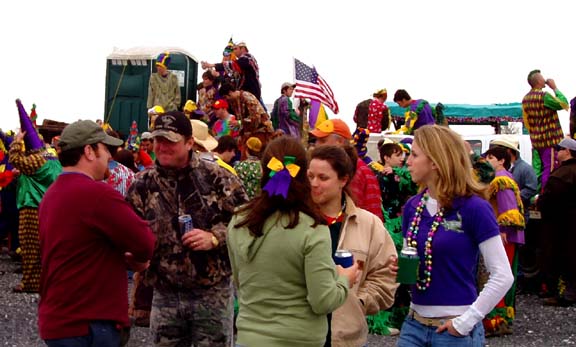Courir de Mardi Gras
In Acadiana the traditional "Courir de Mardi Gras" takes place late in Winter.

Here, where the bayous reach up into the farmland plains of southern Louisiana, the Cajun people have lived these past two hundred years or so. The Mardi Gras they celebrate out here may vary some from town to town, but it is not at all the same as they do in The Big Easy, across the great Atchafalaya waterway in New Orleans, and the people I stayed with here do not easily identify with their cousins, the Genteel Acadians that had settled among the Creoles in the cities of the Mississippi delta.
As a matter of fact, there's about as much difference between the Cajuns and the Creoles as there is between the people where I was raised in the countryside of Northern California and the people of Los Angeles— even more, perhaps. In the cities of Louisiana, Mardi Gras is closer to the Mediterranean tradition of Carnival, and they encourage tourists to come from all over to party. On the open prairies to the west things are closer to the land, and nearer it seems to the heart.
Here, the traditional "Courir de Mardi Gras" retains much more of its medieval character as a costumed begging procession through the countryside, on horseback and in wagons, similar in ways to the Celtic "Samhain" that we recognize as our Hallowe'en. The costumes— fringed pajama affairs with patches of bright colors much like those of the medieval harlequin— are very traditional caricatures of people who take themselves too seriously, and often feature the tall cone-shaped "capuchon" or dunce-cap that satirizes the headdresses worn by the ladies of the medieval court. There seems something built into the Cajun mind that refuses to take itself too seriously; "We work hard, and we play hard, and we laugh at ourselves as much as we do at anyone else" I was told.
Now the towns of Louisiana are very different in heritage and character from one another, and each has a strong opinion of its neighbors— unlike the suburbs of California, which begin to look so much alike that you can always find the bathroom in any MacDonalds, sight unseen. And yet, although the runs may vary some from town to town, there are certain fundamentals that are kept consistent— the presence of the Capitain, for example. His is a respected position that is held for life, or at least until he chooses a successor to replace him, and he is the absolute authority that rules throughout the ride. Dressed finely in his cape and broad-brimmed hat, and flourishing his flag, he rides always at the head of the procession.
When a farm is approached, all the riders rein up and wait patiently while he alone approaches the house to ask permission to come onto the property. When permission is given (and I can't imagine it would not be) he signals with his flag, and the riders enter to perform tricks— dancing on their saddles and climbing trees— to wheedle foodstuffs such as rice, okra and sausages from the farmer. The finest prize of all, it seems, is a chicken thrown high into the air for the men to chase down, not unlike the greased pig chases I can remember as a child in California.
I was able to get a close look at two runs and photograph them, a very traditional one in Church Point that keeps close to the original form, and another, larger one in Eunice that has adapted to more modern forms, and seems to draw more tourists— although I noticed no other cameras in the crowd. "Hey, Camera, where you from?" a rider called out to me at one time laughing, and I shouted after him "California!" at which he gave me a strong thumbs up and a wave before rejoining the procession streaming past me.
Return to Running With the Mardi Gras
